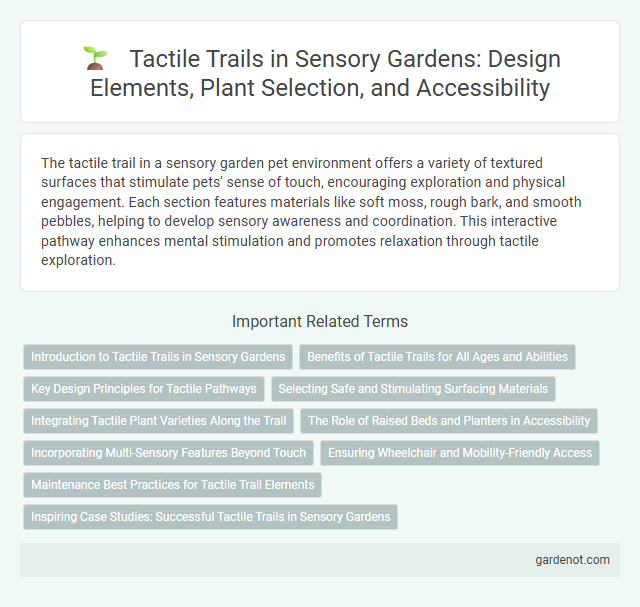The tactile trail in a sensory garden pet environment offers a variety of textured surfaces that stimulate pets' sense of touch, encouraging exploration and physical engagement. Each section features materials like soft moss, rough bark, and smooth pebbles, helping to develop sensory awareness and coordination. This interactive pathway enhances mental stimulation and promotes relaxation through tactile exploration.
Introduction to Tactile Trails in Sensory Gardens
Tactile trails in sensory gardens provide a dynamic pathway designed to engage the sense of touch through varied textures and materials. These trails enhance sensory stimulation and cognitive development for individuals with visual impairments or sensory processing challenges. Incorporating natural elements like smooth stones, rough bark, and soft moss, tactile trails foster inclusive outdoor experiences and promote mindfulness.
Benefits of Tactile Trails for All Ages and Abilities
Tactile trails in sensory gardens offer significant benefits by engaging multiple senses through varied textures and surfaces, enhancing sensory integration for children, adults, and seniors alike. These trails promote physical activity, improve balance and coordination, and support cognitive development, particularly for individuals with sensory processing disorders or disabilities. Incorporating tactile elements fosters inclusive environments that encourage exploration, relaxation, and therapeutic experiences for people of all abilities.
Key Design Principles for Tactile Pathways
Tactile pathways in sensory gardens prioritize texture variation, ensuring diverse surface materials guide users through distinct tactile experiences. Strategic placement of these pathways enhances accessibility for individuals with visual impairments, promoting safe navigation and spatial awareness. Incorporating consistent tactile markers and gradual transitions supports intuitive wayfinding and sensory engagement throughout the garden.
Selecting Safe and Stimulating Surfacing Materials
Choosing surfacing materials for a tactile trail in a sensory garden involves prioritizing safety and sensory stimulation. Materials such as rubber mulch, textured pavers, and soft bark chips provide varied tactile experiences while reducing slips and falls. Selecting non-toxic, durable, and weather-resistant surfaces ensures long-term usability and enjoyment for visitors of all ages and abilities.
Integrating Tactile Plant Varieties Along the Trail
Integrating tactile plant varieties along the sensory garden's tactile trail enhances sensory engagement by offering diverse textures such as soft lamb's ear, rough lamb moss, and spiky ornamental grasses. These carefully selected plants stimulate touch and encourage exploration, fostering a deeper connection with nature for visitors of all ages and abilities. Strategic placement of tactile plants enriches the trail's interactive experience and supports therapeutic benefits for sensory development.
The Role of Raised Beds and Planters in Accessibility
Raised beds and planters in tactile trails enhance accessibility by providing comfortable, elevated surfaces for exploring diverse textures and plants. These structures accommodate wheelchair users and individuals with limited mobility, allowing easy reach and interaction with aromatic herbs, textured leaves, and varied soil types. Thoughtfully designed raised beds also help guide visitors through sensory experiences, fostering engagement and inclusion in sensory gardens.
Incorporating Multi-Sensory Features Beyond Touch
The tactile trail in a sensory garden integrates diverse multi-sensory elements such as sound-producing plants, aromatic herbs, and varied textured materials to engage sight, smell, and hearing alongside touch. Features like wind chimes, scented flower beds, and gravel pathways enhance sensory stimulation and accessibility for users of all abilities. This holistic design approach promotes cognitive development and sensory integration while enriching the outdoor experience.
Ensuring Wheelchair and Mobility-Friendly Access
A tactile trail in a sensory garden enhances engagement by integrating textured paths designed for sensory stimulation that accommodate wheelchair and mobility aid users. Surfaces are crafted from non-slip, firm materials with gradual slopes, ensuring ease of movement and safety for individuals with limited mobility. Clear, low-height signage and resonant markers promote accessible navigation, fostering an inclusive environment for all visitors.
Maintenance Best Practices for Tactile Trail Elements
Regular inspection and cleaning of tactile trail elements ensure durability and safety for all users. Use non-toxic, weather-resistant materials for repairs to maintain texture clarity and prevent wear. Documenting maintenance schedules and promptly addressing damages enhance accessibility and user experience in sensory gardens.
Inspiring Case Studies: Successful Tactile Trails in Sensory Gardens
Successful tactile trails in sensory gardens, such as the Enchanted Forest Sensory Garden in Scotland and the Dream Garden in the Netherlands, demonstrate the profound impact of textured surfaces, interactive sculptures, and varied materials on enhancing sensory engagement and accessibility for visually impaired visitors. These case studies highlight the integration of natural elements with innovative design to stimulate touch, balance, and spatial awareness, fostering inclusive outdoor experiences. Evidence from visitor feedback and sensory therapy sessions confirms increased sensory stimulation and emotional well-being through these effective tactile trail implementations.
Tactile trail Infographic

 gardenot.com
gardenot.com